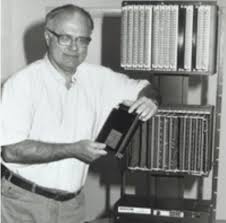
The numbers are in, and they are shocking — 14,135 robots valued at $788 million, or $55,000 per robot, were ordered from North American robot producers in the first half of 2014, an increase in sales that smashed the previous record and raises new questions for manufacturers.
Not surprisingly, many new orders come from the automotive sector, which as we reported in Blue Heron Journal with Nissan Vice President of Purchasing Rebecca Barker Vest, can't grow fast enough at 16 percent.
Money is cheap and companies are sitting on a lot of it. So why not bring in the robots, sit back and let the machines do all the work? Dick Morley, serial entrepreneur and creator of the programmable logic controller (PLC) said he believes that timing is everything, and what we need is more than isolated robots programmed to handle the heavy lifting.
“It’s about intelligence, moving the data flows from one machine to another, seamless, integrated, with the kind of analytics and exception reporting that human intelligence can manage. Because believe me, my friends, it’s still the wetware that runs the robots,” he said.
While early PLC work at GM, for instance, proved the PLC’s application, many manufacturing centers were slow to put the pieces together, even as they unplugged computers and moved critical shop floor data flows to white boards — that’s right, white boards.
There has to be a better way, according to Morley, a backwoods New Hampshire geek and winner of the Prometheus Award. He pointed out that this is not the way we’ve been innovating for the past 50 years.
 “Nobody wants their kid putting tires on a Buick, so it’s going to be hard to get new college grads into manufacturing. And that means we have to design simpler control systems so regular people can run them — smartphones and iPads, small computational devices like sensors are magic.”
“Nobody wants their kid putting tires on a Buick, so it’s going to be hard to get new college grads into manufacturing. And that means we have to design simpler control systems so regular people can run them — smartphones and iPads, small computational devices like sensors are magic.”
“But don’t let the software people design the equipment,” said Morley.
And here’s why: “Tech is irrelevant, but necessary. We’re doing a startup, half a million dollars to start. We’ve budgeted $150,000 for a Harvard MBA. That’s right, first hire an MBA, plus $50,000 for travel plus some bonus money. And we told him to spend a year deciding what the market needs. There will be no engineers involved for a year. Tech is irrelevant but necessary.”
Wow, that’s a huge change from the Big Project approach that put a man on the moon.
“That’s right,” said Morley. “We’ve got all of the technology we can eat right now.

Here’s the story he told the board:
“Somebody comes to us with a dog food business proposal. The new product line of canine victuals is going to be green and organic, beautifully packaged, supported by a perfectly targeted marketing campaign. Heavenly Bites will sell at half the price of ordinary dog food, with twice the nutrition packed into each bite. We’ll use one-third the manufacturing cost, and each bag is going to be 25 percent lighter to ship.”
It was a perfect pitch. But down at the other end of the table, Harry Healer, another New Hampshire venture capital veteran, raised his hand.
“I do have one question,” he said.
“Yes, go ahead,” urged the speaker.
“But will the dog eat the food?”

Named by Fortune magazine a "Pioneering Woman in Manufacturing," Patricia E. Moody, The Mill Girl at Blue Heron Journal, tricia@patriciaemoody.com, is a business visionary, author of 14 business books and hundreds of features. A manufacturing and supply management consultant for more than 30 years, her client list includes Fortune 100 companies as well as start-ups. She is the publisher of Blue Heron Journal, where she created the Made In The Americas (sm), the Education for Innovation (sm) and the Paging Dr. Lean (sm) series. Her next book about the future of manufacturing is The Fourth Industrial Revolution. Copyright Patricia E. Moody 2013. With permission.


